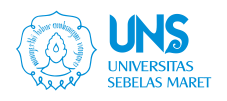Pengembangan Sensor Kimia Berbasis Kertas untuk Penentuan Kadar Flavonoid Total Ekstrak Daun Jambu Biji
Abstract
Sensor kimia berbasis kertas adalah piranti analisis yang menggunakan membran berpori berupa kertas untuk imobilisasi reagen kimia dan deteksi analit pada sampel volume kecil (μL – nL). Sensor kimia flavonoid total dikembangkan dengan cara melakukan ko-imobilisasi larutan aluminium klorida (AlCl3), natrium nitrit (NaNO2), dan natrium hidroksida (NaOH) pada kertas menggunakan teknik adsorpsi. Penambahan larutan kuersetin dapat mengubah warna sensor dari putih menjadi kuning yang kemudian dapat ditangkap dan dikuantifikasi dengan program ImageJ, yang dikenal sebagai teknik skanometri. Karakterisasi analitik seperti linearitas, Limit of Detection (LOD), Limit of Quantification (LOQ), presisi dan akurasi sensor dilakukan dengan menggunakan standar kuersetin. Hasil penentuan kadar flavonoid total sampel daun jambu biji menggunakan metode sensor kimia-skanometri menunjukkan kesesuaian dengan metode spektrofotometri, sehingga memiliki potensi sebagai metode alternatif untuk penentuan kadar flavonoid total.
Development of Paper-Based Chemical Sensor for Determining The Total Flavonoid Content in Guava Leaf Extract. Paper-based chemical sensors are analytical devices that utilize porous paper membranes for reagent immobilization and analyte detection in small sample volumes (μL – nL). The total flavonoid chemical sensor was developed by co-immobilizing aluminum chloride (AlCl3), sodium nitrite (NaNO2), and sodium hydroxide (NaOH) solutions onto paper by using the adsorption technique. The introduction of a quercetin solution changed the sensor's color from white to yellow, which subsequently can be captured and quantified using the ImageJ program, known as the scanometric technique. The sensor's analytical characteristics, such as linearity, limit of detection (LOD), limit of quantification (LOQ), precision, and accuracy, were evaluated using a quercetin standard. The results of determining the total flavonoid content of guava leaf samples using the chemical sensor-scanometric method showed agreement with the spectrophotometric method, indicating its potential as an alternative method for determining total flavonoid content.
Keywords
Full Text:
PDFReferences
Badan Pengawas Obat dan Makanan, 2024. Cek Produk BPOM: Psidii, HT142300431 dan HT142600421. <https://cekbpom.pom.go.id/all-produk?query=PSIDII> (diakses pada 25 September 2025).
Bhardwaj, R., and Naruka, D., 2023. The Phytochemical Screening and Antibacterial Activity of Leaf and Fruit Extracts of Guava (Psidium guajava). The Indian Journal of Agricultural Sciences, 93, 1220–1224. https://doi.org/10.56093/ijas.v93i11.141132.
Bilal, K., Mehboob, F., Akhtar, N., Mirza, I.A., Okla, M.K., Dar, M.J., Saleh, I.A., Zomot, N., and Fatima, H., 2024. Wound Healing, Antioxidant and Antibacterial Activities of Polyphenols of Psidium guajava L. Leaves. South African Journal of Botany, 165, 538–551. https://doi.org/10.1016/j.sajb.2023.12.026.
Díaz-de-Cerio, E., Girón, F., Pérez-Garrido, A., Pereira, A.S.P., Gabaldón-Hernández, J.A., Verardo, V., Segura Carretero, A., and Pérez-Sánchez, H., 2023. Fishing the Targets of Bioactive Compounds from Psidium guajava L. Leaves in the Context of Diabetes. International Journal of Molecular Sciences, 24, 5761. https://doi.org/10.3390/ijms24065761.
Díaz-de-Cerio, E., Pasini, F., Verardo, V., Fernández-Gutiérrez, A., Segura-Carretero, A., and Caboni, M.F., 2017. Psidium guajava L. Leaves as Source of Proanthocyanidins: Optimization of the Extraction Method by RSM and Study of the Degree of Polymerization by NP-HPLC-FLD-ESI-MS. Journal of Pharmaceutical and Biomedical Analysis, 133, 1–7. https://doi.org/10.1016/j.jpba.2016.10.011.
El Sayed, S., 2023. Chromo-Fluorogenic Chemosensors for Sensing Applications, in: Fundamentals of Sensor Technology. Elsevier, pp. 631–667. https://doi.org/10.1016/B978-0-323-88431-0.00020-X.
Farmakope Herbal Indonesia II Edition, 2017. Kementerian Kesehatan Republik Indonesia, Jakarta
Farmakope Indonesia VI Edition, 2020. Kementerian Kesehatan Republik Indonesia, Jakarta
Hidayat, M.A., Ilham, H., Ningsih, I.Y., and Kuswandi, B., 2025. The ABTS-Microzone Plate and Scanometry as a Simple and Fast Colorimetric Assay for Determining the Total Antioxidant Capacity of Plant Extract. Chemical Papers, 79, 775–782. https://doi.org/10.1007/s11696-024-03813-8.
Hidayat, M.A., Chassana, R.I., Ningsih, I.Y., Yuwono, M., and Kuswandi, B., 2019. The CUPRAC-Paper Microzone Plates as a Simple and Rapid Method for Total Antioxidant Capacity Determination of Plant Extract. European Food Research and Technology, 245, 2063–2070. https://doi.org/10.1007/s00217-019-03312-1.
Hidayat, M.A., Maharani, D.A., Purwanto, D.A., Kuswandi, B., and Yuwono, M., 2020. Simple and Sensitive Paper-based Colorimetric Biosensor for Determining Total Polyphenol Content of the Green Tea Beverages. Biotechnology and Bioprocess Engineering, 25, 255–263. https://doi.org/10.1007/s12257-019-0299-8.
Hidayat, M.A., Rohmah, A., Ningsih, I.Y., and Kuswandi, B., 2023. Development of the Paper-based Colorimetric Sensor for Simple and Fast Determination of Quercetin in Guava Leaf Extract. Analytical Sciences, 39, 1703–1710. https://doi.org/10.1007/s44211-023-00380-y.
Huber, L., 2007. Validation and Qualification in Analytical Laboratories, second ed. Informa Healthcare. USA, New York.
Indrayanto, G., 2021. VMA-Solutions Version 1.5.1. https://github.com/blue-wind-25/VMA-Solutions/releases/tag/1.5.1.
Indrayanto, G., 2018. Validation of Chromatographic Methods of Analysis: Application for Drugs That Derived from Herbs, in: Profiles of Drug Substances, Excipients and Related Methodology. pp. 359–392. https://doi.org/10.1016/bs.podrm.2018.01.003.
Kuswandi, B., 2010. Sensor Kimia (Teori, Praktek dan Aplikasi). Jember University Press, Jember.
Kuswandi, B., Fantoni, M., Hidayat, M.A., and Ningsih, I.Y., 2020. Paper Microzone Plate Based on DPPH as a Simple Colorimetric Assay of the Total Antioxidant Content of Herbal Extracts. Journal of Food Science and Technology, 57, 1971–1976. https://doi.org/10.1007/s13197-020-04378-6.
Kuswandi, B., Prihandini, K., and Hidayat, M.A., 2024. Determination of Lead in Herbal Medicine by a Lab-on-a-Tip (LOT) Optical Fiber Sensor. Analytical Letters, 57, 1611–1621. https://doi.org/10.1080/00032719.2023.2264421.
Qin, J., Wang, J., Shao, X., Zhang, S., Chen, X., Lai, D., Xiao, W., Zhuang, Q., and Kuang, S., 2023. Evaluation of Bioactive Compounds, Antioxidant Capacity and Mineral Elements in the Leaves of Guava (Psidium guajava L.) Genotypes from China. Scientia Horticulturae, 322, 112436. https://doi.org/10.1016/j.scienta.2023.112436.
Shraim, A.M., Ahmed, T.A., Rahman, M.M., and Hijji, Y.M., 2021. Determination of Total Flavonoid Content by Aluminum Chloride Assay: A Critical Evaluation. LWT, 150, 111932. https://doi.org/10.1016/j.lwt.2021.111932.
Sultana, S., Hossain, M.L., Sostaric, T., Lim, L.Y., Foster, K.J., and Locher, C., 2024. Investigating Flavonoids by HPTLC Analysis Using Aluminium Chloride as Derivatization Reagent. Molecules, 29, 5161. https://doi.org/10.3390/molecules29215161.
Yuwono, M., and Indrayanto, G., 2005. Validation of Chromatographic Methods of Analysis, in: Brittain, H. (Ed.), Profiles of Drug Substances, Excipients and Related Methodology. Academic Press, Cambridge, pp. 243–259. https://doi.org/10.1016/S0099-5428(05)32009-0.
Refbacks
- There are currently no refbacks.

_(1).jpg)




.png)



.png)

